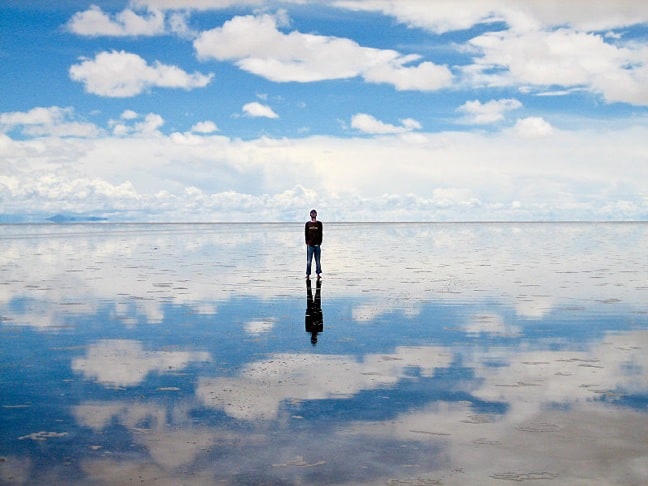Salar de Uyuni: Nature’s Largest Natural Mirror
The world brims with wonders, and some of the most fascinating are those crafted entirely by natural processes, untouched by human hands. South America unveils a treasure trove of distinctive natural landscapes that can offer a once-in-a-lifetime experience to travelers. Among these marvels lies Salar de Uyuni, the world’s largest salt flat, nestled in Bolivia.
A Boundless Natural Mirror
Salar de Uyuni sprawls across a staggering 10,582 square kilometers, earning the distinction of being Earth’s most extensive natural mirror. This salt flat graces the region between Potosi and Oruro, near the pinnacle of the Andes Mountains in Bolivia. The salt flat’s formation traces back to several prehistoric lakes that underwent transformations approximately 30,000 to 42,000 years ago, as National Geographic reported.
A blanket of salt, several feet thick, shrouds the surface of Salar de Uyuni, ensuring the area remains arid year-round. In this southwestern Bolivian region, the flat receives only sporadic instances of rainfall each year, resulting in a thin veneer of water overlaying the salt flat. During these fleeting moments, Salar de Uyuni metamorphoses into the largest natural mirror on the planet.
Its perfectly level and crystal-clear surface reflects the expanse of sky and the ballet of clouds overhead, bestowing a breathtaking spectacle upon anyone fortunate enough to behold it. Despite its searing appearance, Salar de Uyuni boasts relatively mild temperatures, oscillating between 13 to 21 degrees Celsius.

A Magnet for Tourists
Each year, tourists hailing from all corners of the globe converge upon to bear witness to this colossal mirror phenomenon. Beyond merely gazing upon the mirror-like expanse, visitors also revel in the opportunity to observe colonies of pink flamingos that consider this salt flat their sanctuary.
The term “Salar” translates to salt flat, while “Uyuni” derives from the Aymara language, signifying a pen or vast stretch. Uyuni also designates a town that serves as the portal for tourists embarking on journeys to visit the salt flat. Consequently, Salar de Uyuni can be construed as the salt flat stretch in the town of Uyuni.
A Natural Marvel and Geological Wonder
Salar de Uyuni is not solely a natural marvel but also a geological wonder. Its vast dimensions and unique attributes render it a destination of unparalleled distinction. As travelers traverse this seemingly boundless expanse of salt, they partake in the surreal experience of treading upon a mirror that mirrors the heavens.
Beyond its striking visual allure, assumes a pivotal ecological role as the habitat for diverse species, including the emblematic pink flamingos. The myriad ecosystems and distinctive geological formations encircling the salt flat augment its appeal as a must-visit destination for nature enthusiasts and intrepid explorers.
The Enchantment of Salar de Uyuni
This distinctive natural landscapes, with its expansive proportions and natural mirror phenomenon, stands as a testament to the awe-inspiring forces of nature. It showcases our planet’s beauty and diversity, beckoning travelers to witness one of nature’s most remarkable and entrancing displays. Whether captivated by the mirror-like reflections or intrigued by the region’s rich biodiversity, Salar de Uyuni pledges an indelible sojourn into the heart of Bolivia’s natural wonders.
